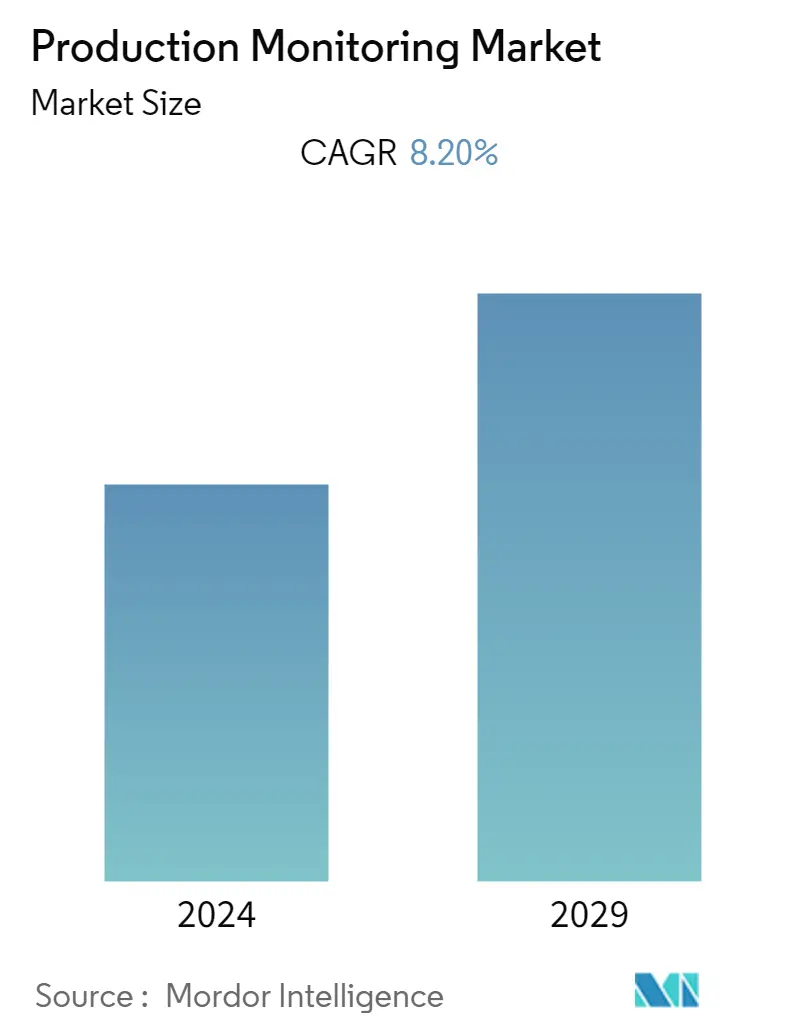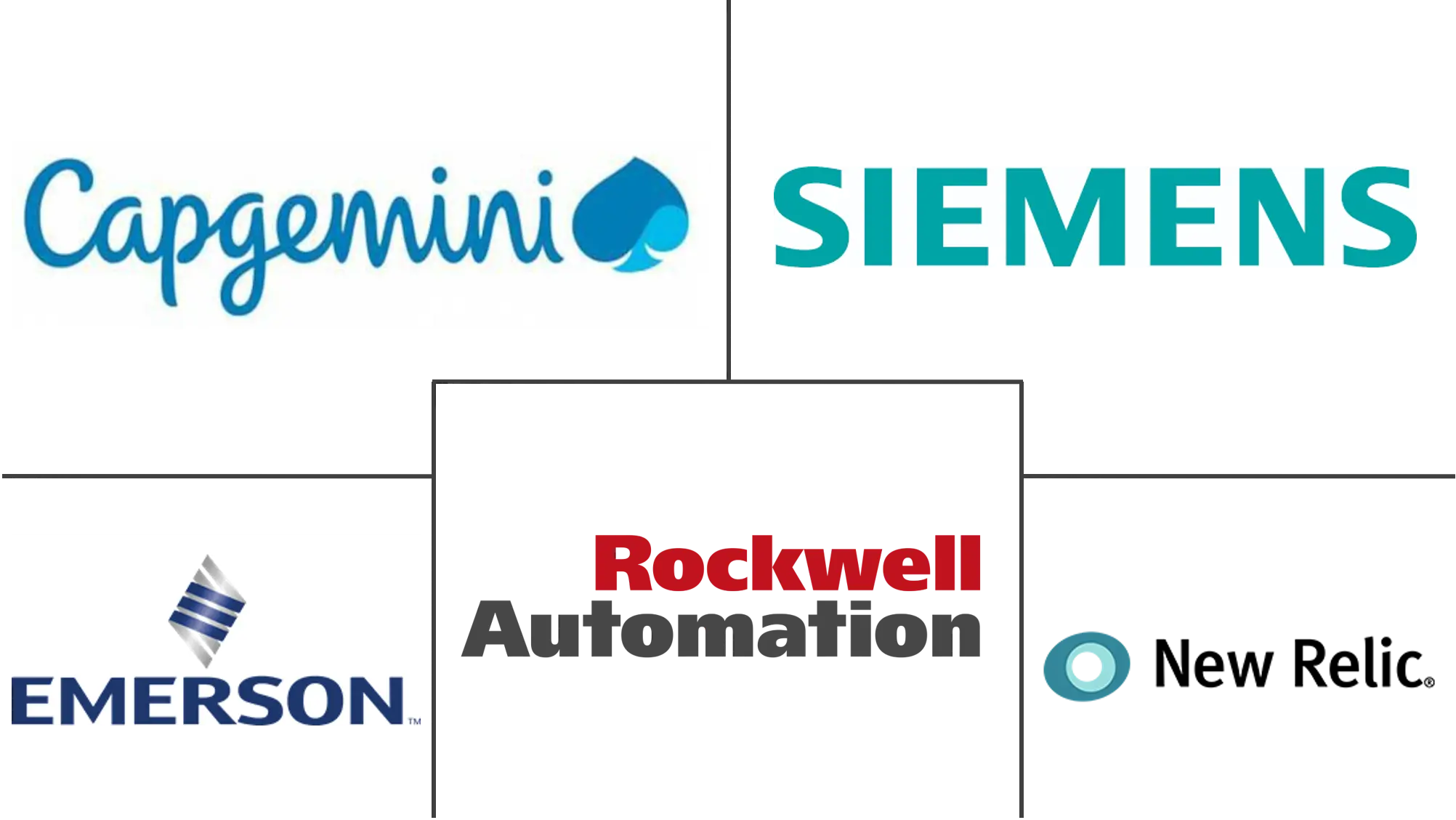| Study Period | 2019 - 2029 |
| Base Year For Estimation | 2023 |
| Forecast Data Period | 2024 - 2029 |
| CAGR | 8.20 % |
| Fastest Growing Market | Asia Pacific |
| Largest Market | North America |
| Market Concentration | Low |
Major Players*Disclaimer: Major Players sorted in no particular order |
Production Monitoring Market Analysis
The production monitoring market is expected to register a CAGR of 8.2% during the forecast period, 2021-2026. Due to a number of economic, radical, and market factors across the world, a significant revolution has been happening within the manufacturing industry. Both augmented reality (AR) and virtual reality (VR) in Industry 4.0 bridge the gap between the digital/cyber/virtual world and the physical world. VR and AR technology, when integrated into a factory environment and equipment via devices and sensors, can help keep track of the manufacturing processes and production. This helps optimize and enhance machine productivity (quantity, quality, speed, and flexibility), improving the overall ROI of the enterprise. In April 2020, Flex decided to enhance its global manufacturing processes and delivering customer solutions through augmented/virtual reality, which may help in design, usability, and product lifecycle management. Further implementations by other players may provide a future trend in the production monitoring market.
- Demand for a centralized monitoring system with predictive maintenance of assets drives the market. Predictive maintenance has been adopted recently in the heavy manufacturing industry, such as predictive maintenance of a gas turbine, a vacuum pump, and an aircraft engine. Overall, the predictive maintenance framework is able to perform real-time detection, visualization, alert creation, as well as recommendations for fixes on different stages of the manufacturing process through the centralized system.
- Players are focused on implementing a solution that can be integrated with predictive maintenance. In April 2020, Kistler introduced a flexible, new amplifier for industrial applications and a miniature charge amplifier with IO-Link suitable for use in robotics, the packaging industry, the food and the beverage sector, and for OEMs. IO-Link technology supplies users with real-time data to monitor the condition of their plants and measurement chains through predictive maintenance.
- The adoption of IoT-based solution for control and monitoring of additive manufacturing processes drives the market. According to AMFG, as of 2019, the additive manufacturing industry was estimated to be worth over USD 9 billion, and it is further estimated to be worth more than the current market value in future. Additive manufacturing enables the fast, flexible, and cost-efficient production of parts directly from 3D CAD data. For the management of additive manufacturing machines, the application of beacon technology in the factory environment allows the communication of production indexes extracted from the machines via mobile devices and IoT (Internet of Things).
- Furthermore, two types of beacons can be used where some beacons can broadcast an entire URL, such as the beacons that follow the Eddystone-URL or Ephemeral URL standards. These beacons can directly send the machine HMI Internet Address. With the integration of IoT, the market for production monitoring signifies a potential growth in the coming future.
- The COVID-19 pandemic is growing the demand for production monitoring solutions integrated with cloud deployment for many end users, such as automotive, healthcare, and aerospace. The demand for medical equipment is growing significantly during this pandemic. In April 2020, India and Russia discussed facilitating the emergent needs of equipment on both sides as part of their efforts to contain COVID-19. Both sides decided to be in touch with monitoring and facilitating the emergent needs of the equipment. This inhibits the demand for software solutions mostly deployed through a cloud solution.
- Moreover, in April 2020, RecycleGO collaborated with Mask Force NYC to bring fast-track relief to healthcare providers due to the COVID-19 outbreak in the United States. In less than 14 days, RecycleGO built a fast-track global supply chain and distribution network for Mask Force NYC. Once the masks arrived in New York in April, RecycleGO worked with Mask Force NYC to organize mask distribution logistics using its dual-system logistics operations software. This logistics software is used for dispatchers, mission control, and its route optimization application.
- However, data security concerns and privacy issues are challenging the market growth. Metals, capital goods, and electronics industries are fast becoming inclined to cybersecurity risks, as investments in manufacturing systems are incorporated with connected devices. Manufacturers have become more unsafe for cyber-attacks after shifting toward cloud infrastructure and services.
- The threat has now become very striking to the manufacturing sector, which faces risks from the hacking of the IoT investments to the intellectual IP theft from China and other countries. According to a recent study by Wipro, out of the total critical resources or assets offered on the Dark Web in 2019, 14% were from the manufacturing sector.
Production Monitoring Industry Segmentation
The production monitoring records the overall performance of the production line in real-time through software and service offerings deployed through the cloud or on-premise, providing the monitoring of production to end users, such as oil and gas, chemical, and automotive.
| Solutions |
| Services |
| Cloud |
| On-premise |
| Business Process Optimization |
| Logistics and Supply Chain Management |
| Emergency and Incident Management |
| Automation and Control Management |
| Oil and Gas |
| Chemical |
| Automotive |
| Energy and Power |
| Food and Beverage |
| Aerospace and Defense |
| Healthcare and Life Sciences |
| Other End Users |
| North America | United States |
| Canada | |
| Europe | Germany |
| United Kingdom | |
| France | |
| Rest of Europe | |
| Asia-Pacific | India |
| China | |
| Japan | |
| Rest of Asia-Pacific | |
| Rest of the World | Latin America |
| Middle East and Africa |
Production Monitoring Market Size Summary
The production monitoring market is experiencing significant growth, driven by advancements in technology and the increasing need for efficient manufacturing processes. The integration of augmented reality (AR) and virtual reality (VR) within Industry 4.0 is bridging the gap between digital and physical worlds, enhancing machine productivity and optimizing manufacturing processes. This technological evolution is further supported by the adoption of IoT-based solutions and predictive maintenance systems, which are becoming integral in sectors such as heavy manufacturing, oil and gas, and additive manufacturing. These innovations enable real-time monitoring and data-driven decision-making, improving the overall return on investment for enterprises. The COVID-19 pandemic has accelerated the demand for cloud-based production monitoring solutions, particularly in industries like automotive, healthcare, and aerospace, where the need for efficient supply chain management and rapid response to emerging needs has become critical.
North America stands as the largest contributor to the production monitoring market, benefiting from its advanced technological infrastructure and skilled workforce. The region's industries are increasingly adopting cloud-based applications and data analytics systems to enhance their production monitoring capabilities. Key players in the market, such as Capgemini SE, Siemens AG, and Rockwell Automation Inc., are leveraging strategies like new product launches and strategic partnerships to expand their market presence. Despite the promising growth prospects, the market faces challenges related to data security and privacy, particularly with the rise of cyber threats targeting connected devices in manufacturing systems. Nonetheless, the ongoing digital transformation and automation initiatives across various sectors are expected to drive the market's expansion in the coming years.
Production Monitoring Market Size - Table of Contents
1. MARKET DYNAMICS
- 1.1 Market Overview
-
1.2 Market Drivers
- 1.2.1 Demand for Centralized Monitoring and Predictive Maintenance of Assets
- 1.2.2 Adoption of IoT-based Solution for Control and Monitoring of Additive Manufacturing Processes
-
1.3 Market Restraints
- 1.3.1 Data Security Concerns and Privacy Issues
- 1.4 Industry Value Chain Analysis
-
1.5 Industry Attractiveness - Porter's Five Forces Analysis
- 1.5.1 Threat of New Entrants
- 1.5.2 Bargaining Power of Buyers/Consumers
- 1.5.3 Bargaining Power of Suppliers
- 1.5.4 Threat of Substitute Products
- 1.5.5 Intensity of Competitive Rivalry
- 1.6 Assessment of Impact of COVID-19 on the Industry
2. MARKET SEGMENTATION
-
2.1 Component
- 2.1.1 Solutions
- 2.1.2 Services
-
2.2 Deployment
- 2.2.1 Cloud
- 2.2.2 On-premise
-
2.3 Application
- 2.3.1 Business Process Optimization
- 2.3.2 Logistics and Supply Chain Management
- 2.3.3 Emergency and Incident Management
- 2.3.4 Automation and Control Management
-
2.4 End User
- 2.4.1 Oil and Gas
- 2.4.2 Chemical
- 2.4.3 Automotive
- 2.4.4 Energy and Power
- 2.4.5 Food and Beverage
- 2.4.6 Aerospace and Defense
- 2.4.7 Healthcare and Life Sciences
- 2.4.8 Other End Users
-
2.5 Geography
- 2.5.1 North America
- 2.5.1.1 United States
- 2.5.1.2 Canada
- 2.5.2 Europe
- 2.5.2.1 Germany
- 2.5.2.2 United Kingdom
- 2.5.2.3 France
- 2.5.2.4 Rest of Europe
- 2.5.3 Asia-Pacific
- 2.5.3.1 India
- 2.5.3.2 China
- 2.5.3.3 Japan
- 2.5.3.4 Rest of Asia-Pacific
- 2.5.4 Rest of the World
- 2.5.4.1 Latin America
- 2.5.4.2 Middle East and Africa
Production Monitoring Market Research FAQs
What is the current Production Monitoring Market size?
The Production Monitoring Market is projected to register a CAGR of 8.2% during the forecast period (2025-2030)
Who are the key players in Production Monitoring Market?
Capgemini SE, Siemens AG, Emerson Electric Co., Rockwell Automation Inc. and New Relic Inc. are the major companies operating in the Production Monitoring Market.




